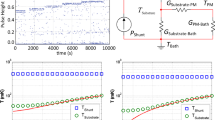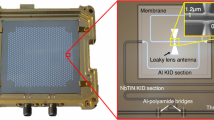Abstract
Background
Quadrature surface MRI/MRS detectors comprised of circular loop and figure-8 or butterfly-shaped coils offer improved signal-to-noise-ratios (SNR) compared to single surface coils, and reduced power and specific absorption rates (SAR) when used for MRI excitation. While the radius of the optimum loop coil for performing MRI at depth d in a sample is known, the optimum geometry for figure-8 and butterfly coils is not.
Materials and methods
The geometries of figure-8 and square butterfly detector coils that deliver the optimum SNR are determined numerically by the electromagnetic method of moments. Figure-8 and loop detectors are then combined to create SNR-optimized quadrature detectors whose theoretical and experimental SNR performance are compared with a novel quadrature detector comprised of a strip and a loop, and with two overlapped loops optimized for the same depth at 3 T. The quadrature detection efficiency and local SAR during transmission for the three quadrature configurations are analyzed and compared.
Results
The SNR-optimized figure-8 detector has loop radius r 8 ~ 0.6d, so r 8/r 0 ~ 1.3 in an optimized quadrature detector at 3 T. The optimized butterfly coil has side length ~ d and crossover angle of ≥50° at the center.
Conclusions
These new design rules for figure-8 and butterfly coils optimize their performance as linear and quadrature detectors.
Similar content being viewed by others
References
Hoult DI, Chen CN and Sank VJ (1984). Quadrature detection in the laboratory frame. Magn Reson Med 1: 339–353
Chen C, Hoult DI and Sank VJ (1983). Quadrature detection coils — a further sqrt(2) improvement in sensitivity. J Magn Reson 54: 324–327
Hyde JS, Jesmanowicz A, Grist TM, Froncisz W and Kneeland JB (1987). Quadrature detection surface coil. Magn Reson Med 4: 179–184
Bottomley PA, Hardy CJ, Roemer PB and Mueller OM (1989). Proton-decoupled, Overhauser-enhanced, spatially localized carbon-13 spectroscopy in humans. Magn Reson Med 12: 348–363
Redpath TW (1986). Quadrature rf coil pairs. Magn Reson Med 3: 118–119
Bottomley PA and Roemer PB (1992). Homogeneous tissue model estimates of RF power deposition in human NMR studies. Local elevations predicted in surface coil decoupling. Ann NY Acad Sci 649: 144–159
Guclu CC, Boskamp E, Zheng T, Becerra R and Blawat L (2004). A method for preamplifier-decoupling improvement in quadrature phased-array coils. J Magn Reson Imaging 19: 255–258
Edelstein WA, Glover GH, Hardy CJ and Redington RW (1986). The intrinsic signal-to-noise ratio in NMR imaging. Magn Reson Med 3: 604–618
Roemer W, Edelstein WA (1987) Ultimate sensitivity limits of surface coils. In: SMRM 6th Annual Meeting, p 410
Chen CN, Hoult DI (1989) Biomedical magnetic resonance technology. Adam Hilger, Bristol, pp 143, 161
Kumar A and Bottomley PA (2006). Optimizing the intrinsic signal-to-noise ratio of MRI strip detectors. Magn Reson Med 56: 157–166
Andreuccetti D, Fossi R, Petrucci C (2002) An Internet resource for calculation of the dielectric properties of body tissues. http://niremf.ifac.cnr.it/tissprop/#refs
Lee RF, Hardy CJ, Sodickson DK and Bottomley PA (2004). Lumped-element planar strip array (LPSA) for parallel MRI. Magn Reson Med 51: 172–183
Pozar DM (1998). Microwave engineering. Wiley, New York
Roemer PB, Edelstein WA, Hayes CE, Souza SP and Mueller OM (1990). The NMR phased array. Magn Reson Med 16: 192–225
Grover FW (1973). Inductance calculations. Dover Publications, Mineola
Wang J, Yang QX, Zhang X, Collins CM, Smith MB, Zhu XH, Adriany G, Ugurbil K and Chen W (2002). Polarization of the RF field in a human head at high field: a study with a quadrature surface coil at 7.0 T. Magn Reson Med 48: 362–369
Bottomley PA and Andrew ER (1978). RF magnetic field penetration, phase shift and power dissipation in biological tissue: implications for NMR imaging. Phys Med Biol 23: 630–643
Glover GH, Hayes CE, Pelc NJ, Edelstein WA, Mueller OM, Hart HR, Hardy CJ, O’Donnell M and Barber WD (1985). Comparison of linear and circular polarization for magnetic resonance imaging. J Magn Reson 64: 255–270
Edelstein WA, Bottomley PA and Pfeifer LM (1984). A signal-to-noise calibration procedure for NMR imaging systems. Med Phys 11: 180–185
Bottomley PA (1986). A practical guide to getting NMR spectra in vivo. In: Budinger, TF (eds) Medical magnetic resonance imaging and spectroscopy, a primer, pp 81–95. Society of Magnetic Resonance in Medicine, Berkeley
Wiesinger F, Vande Moortele PF, Adriany G, De Zanche N, Ugurbil K and Pruessmann KP (2004). Parallel imaging performance as a function of field strength—an experimental investigation using electrodynamic scaling. Magn Reson Med 52: 953–964
Keltner JR, Carlson JW, Roos MS, Wong ST, Wong TL and Budinger TF (1991). Electromagnetic fields of surface coil in vivo NMR at high frequencies. Magn Reson Med 22: 467–480
Collins CM, Li S and Smith MB (1998). SAR and B1 field distributions in a heterogeneous human head model within a birdcage coil. Specific energy absorption rate. Magn Reson Med 40: 847–856
Davis PL, Shang C, Talagala L and Pasculle AW (1993). Magnetic resonance imaging can cause focal heating in a nonuniform phantom. IEEE Trans Biomed Eng 40: 1324–1327
Author information
Authors and Affiliations
Corresponding author
Additional information
This work is supported by NIH grant R01 RR15396.
Rights and permissions
About this article
Cite this article
Kumar, A., Bottomley, P.A. Optimized quadrature surface coil designs. Magn Reson Mater Phy 21, 41 (2008). https://doi.org/10.1007/s10334-007-0090-2
Received:
Revised:
Accepted:
Published:
DOI: https://doi.org/10.1007/s10334-007-0090-2




